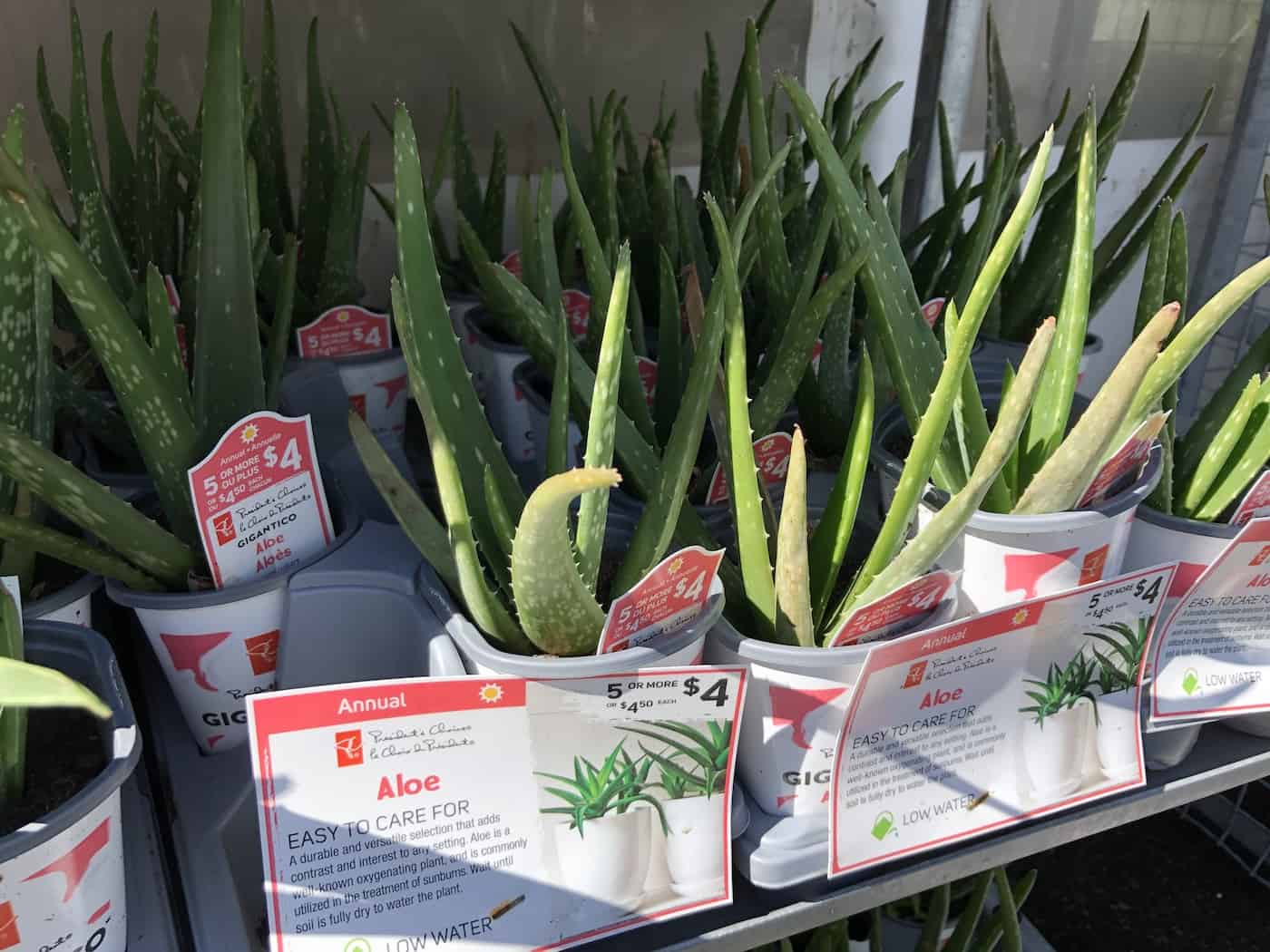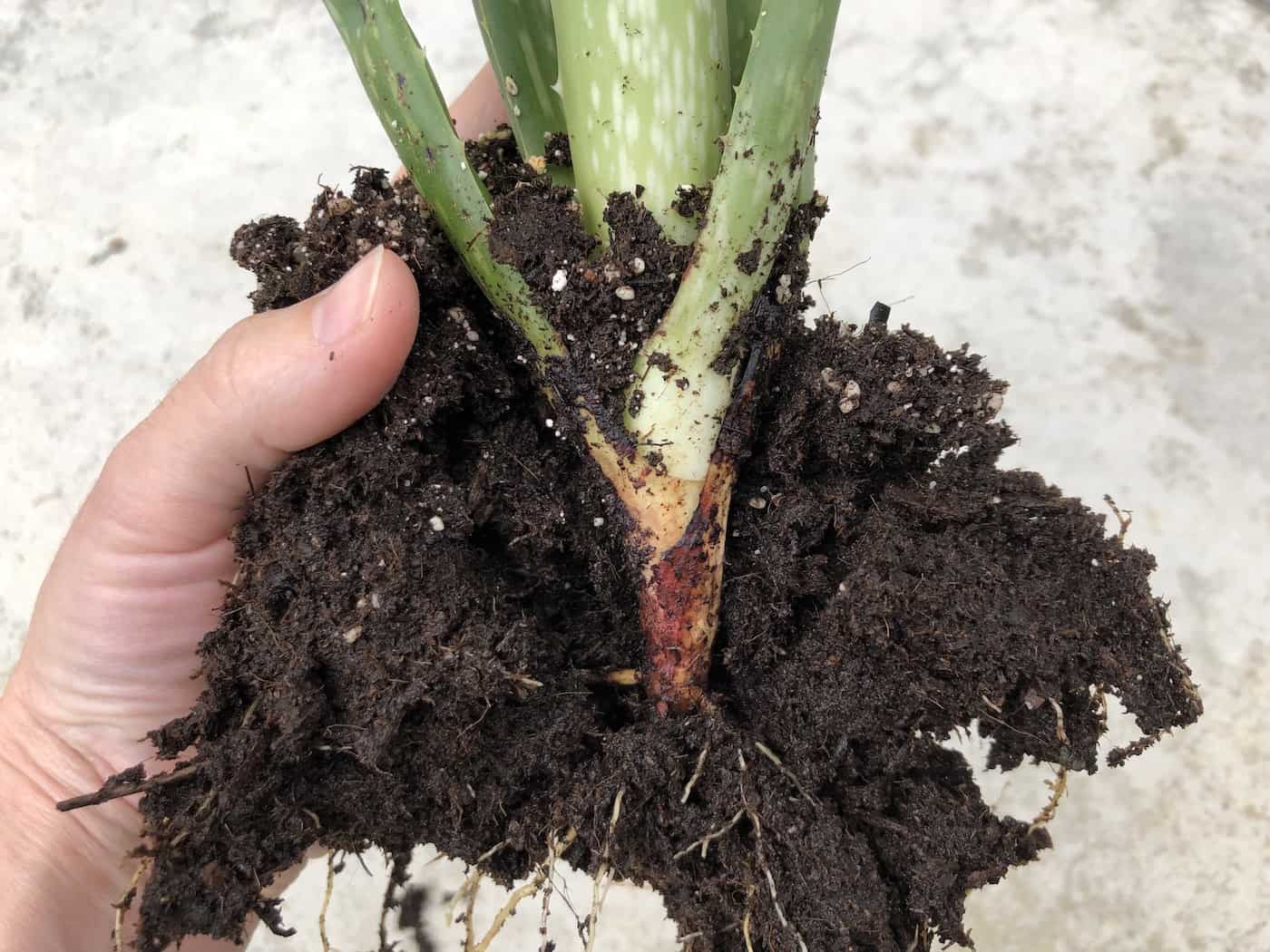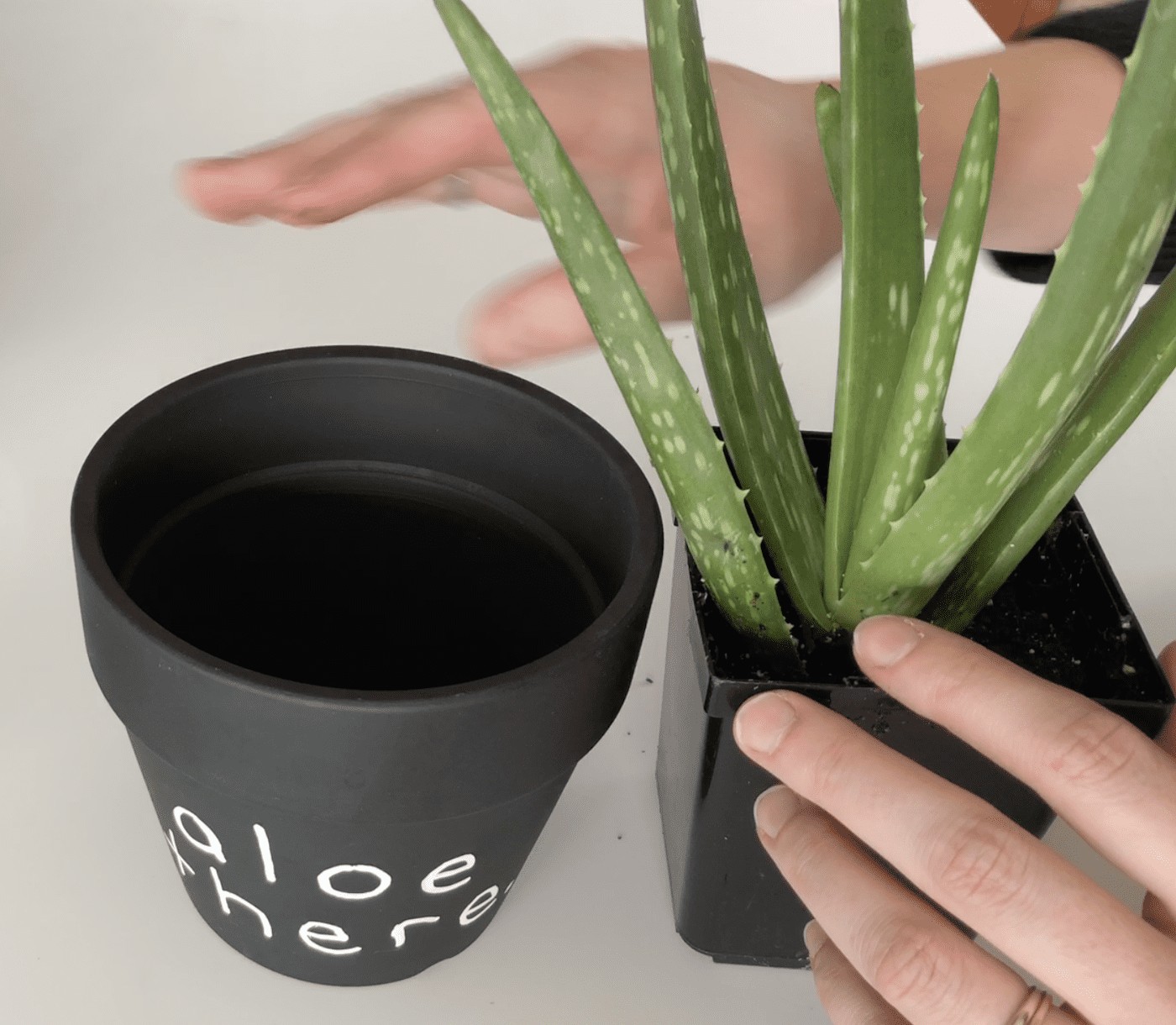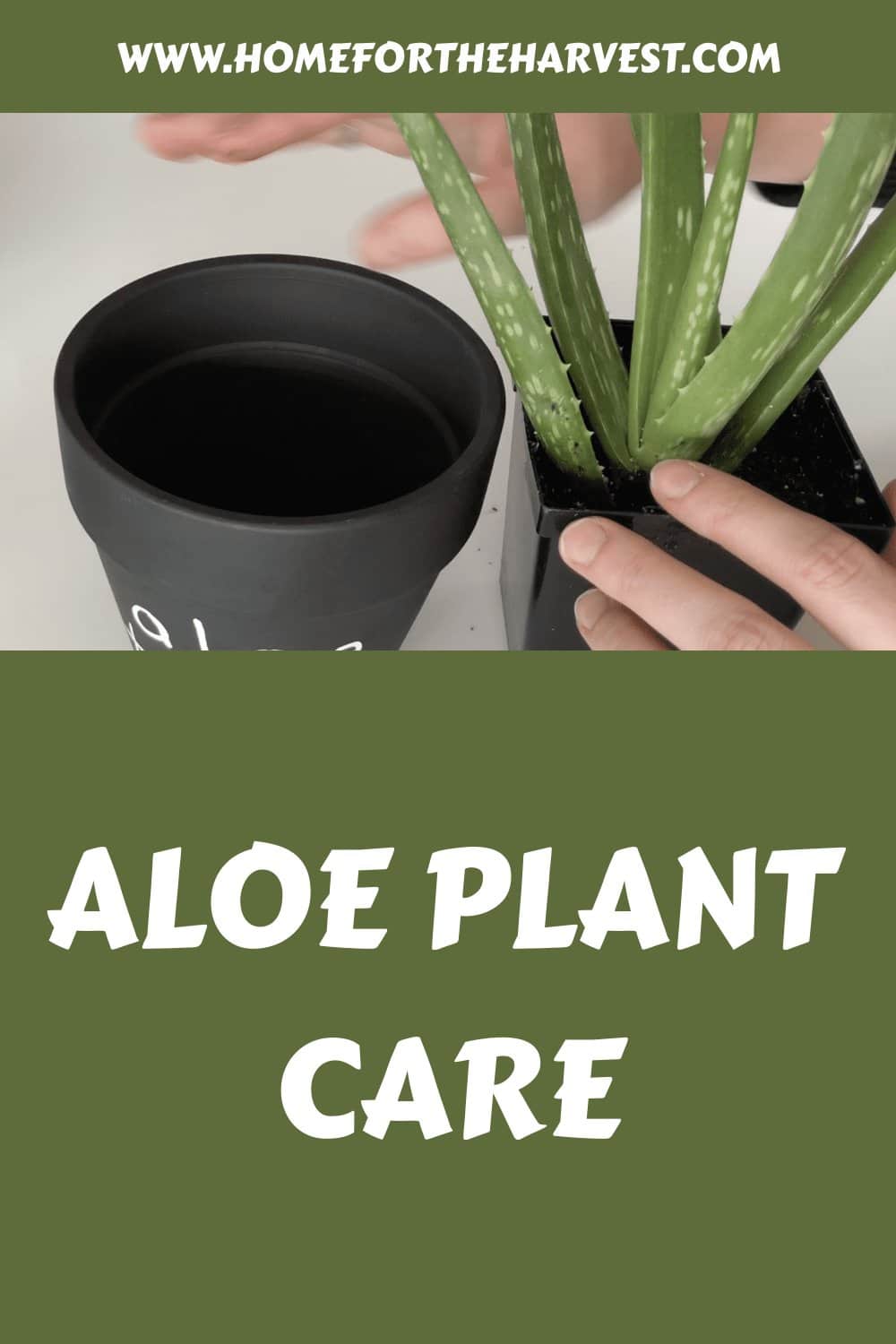Aloe vera is a useful and versatile indoor plant great for beginners in the succulent world.
Aloe vera loves full sun and grows best in front of bright south-facing windows. Give these plants at least 4 hours of direct sun per day. They can go several weeks without water. Only water again when the soil has dried out completely to avoid root rot. They don’t need fertilizing or repotting very often (if at all) and are easy to propagate from offsets.

Aloe plant care basics
Thanks to their love of heat and lack of tolerance for cold weather in this native habitat, growing Aloe vera as a houseplant is common around the world. They can grow and thrive outdoors too, but are only perennials in the warmest climates from USDA Zone 10 and up, as they can’t withstand cold winter temperatures.
As succulents, the Aloe vera plant is not like other common houseplants. It has different needs from tropical favorites like Philodendrons or Pothos, but with a bit of knowledge, it isn’t a difficult plant to care for.

Sunlight requirements for Aloe
Aloe vera, like all Aloe plants and succulents, are lovers of the sunshine. They grow best when given a full day of direct sunlight (or at least six hours). They will still grow in less than full sun but won’t perform to the best of their ability.
Aloe vera plants are not at all tolerant of low lighting conditions. In dark corners and rooms with no windows, the leaves will begin to stretch toward the nearest light source, becoming unbalanced. Growth will slow or stop completely, and the plant will eventually die.
As the quality of sunlight indoors differs from the direct sun outdoors, these plants should be placed on a bright windowsill where they can receive as much direct light throughout the day as possible. Aim for positions in front of south-facing windows or west-facing windows that get bright light all afternoon.
Watering Aloe vera plants in pots
These plants are known for their thick and juicy leaves – one of the reasons they are so beloved around the world. These leaves hold onto plenty of moisture to sustain the plant, allowing it to survive the drought and dry spells of their native habitats incredibly well.
Growing indoors means you can leave the soil to dry out completely before watering again. The Aloe vera plant is highly susceptible to root rot and shouldn’t be watered when the top layer of soil is still moist. It’s far safer to underwater these plants than overwater them.
In general, you’ll only need to water your Aloe vera plant once every two weeks or so, waiting even longer when the weather is cool. As environments differ, it’s best to lift the pot every couple of days to determine the level of moisture in the soil and only water when the pot is light, indicating all the moisture has evaporated.
Humidity preferences of Aloe plants
Unlike other popular tropical houseplants, Aloe vera is not fussy about humidity conditions. They will be happy almost anywhere, even when the air is quite dry. This makes them ideal for drier areas of your home with humidity below 40% where other houseplants would struggle.
Temperature requirements for Aloe vera
Regular indoor temperatures are suitable for Aloe vera plants, explaining why they are generally grown as houseplants around the world.
Aim to keep temperatures warm year-round, between 65F and 85F, for the strongest growth. They can handle temperatures down to 50F, but will generally stop growing when temperatures drop too low.
Never leave these plants outside during fall or winter if the temperature drops below 40F at night. They can face serious cell damage that leads to dead leaves and a suffering plant. If they are near windows during winter, make sure the leaves do not touch the glass where cold collects.

Repotting Aloe plants
Your Aloe vera plant won’t require repotting very often, if at all. They generally prefer to be root bound rather than given too much space as excess soil holds onto moisture and can rot the roots.
If you want to move your Aloe vera plant to a different pot or need to give a young plant more space to mature, the process is simple.
Start by removing the plant from the existing pot. Tease the roots gently to release them, especially if they are circling around each other. You can also use this opportunity to remove any pups next to the plant, ready for propagation.
Fill a pot with a well-draining succulent and cacti soil mix. You can purchase these mixes online or at your local nursery. Alternatively, you can make your own soil mix by amending one part high-quality potting soil with one part coarse sand. This matches the gritty, well-draining texture they are used to in their native habitats.
Make a hole in the center of the pot and transplant the Aloe, making sure you don’t bury any of the leaves to prevent rotting. Wait a couple of days for the plant to settle before watering, limiting shock and reducing the chances of root rot.
Fertilizing Aloe vera
The low-maintenance nature of these plants extends to their fertilizing needs. Aloe vera doesn’t really require fertilizing, preferring the low-nutrient soils of their native habitats. They are happy to grow without additional nutrients, as long as the soil is changed out every couple of years when repotting.
If you would like to give your Aloe a boost, you can fertilizer once per year in spring. Look for a fertilizer designed for succulents – usually higher in phosphorus – and apply only at half strength to avoid burning the roots and leaves.
Harvesting Aloe vera gel
One of the greatest benefits of growing Aloe vera indoors is the instant supply of Aloe vera gel. This gel can be used as a topical skin treatment or mixed into creams for a heavily moisturizing lotion.
To harvest Aloe vera gel from inside the Aloe leaves, start by finding an older leaf that is thick and juicy. Remove it from the base of the plant, cutting as close to the center as possible.
Place the leaf on a cutting board and remove the pointed edges to make extraction easier. Then, slice off the top and bottom layer of outer skin to reveal the clear Aloe gel underneath. The gel should be completely transparent once rinsed under the tap.
Propagating Aloe vera
There are many ways to propagate Aloe vera plants, but some yield quicker results than others. Propagating from Aloe vera pups or offsets is most common, giving you a brand new plant almost instantly. These plants can also be propagated from leaf cuttings or seeds, but these methods generally aren’t as successful.
When your Aloe has grown large enough, it should start producing pups at the base that look like tiny versions of the mother plant. All you need to do is remove these offsets and repot them, allowing the plant to do all the hard work for you. Wait until the pup has a few leaves before removing it to ensure it can grow successfully on its own.
This process is best done when repotting as you’ll need to start by removing the plant from its existing pot and teasing the soil away from the roots. Identify the areas where the pups connect to the mother plant and cut them off, keeping as many roots as possible with the offset for quick establishment.
Leave the offset on a piece of newspaper in a dry spot for a day or two to allow the cut to seal over. This prevents any potential rotting once planted. Then, as with repotting, fill a pot with a succulent potting mix and plant the new pup in the center. Water after planting to help the roots settle in their new home and to encourage new root growth.
Pests affecting Aloe plants
Aloe vera is not highly prone to pest problems, especially when grown indoors. However, you may come across a few common houseplant pests, especially if they have spread from your other houseplants to your Aloe vera.
Look out for scale, aphids and the dreaded spider mite. These sap-sucking pests will leave spots all over the leaves of your plants and slow growth over time if not controlled. Start by washing any pests you find off the plant and apply an insecticidal soap as needed until all signs of pest problems have disappeared.

Diseases affecting Aloe plants
Diseases are not common in Aloe vera plants but can certainly occur. Usually, diseases are exacerbated by overly wet soil, dark conditions, and a lack of air circulation around the plant.
The first to watch for is root rot, caused by the presence of fungus in the soil in overly moist conditions. This will rot the roots and stems, seriously damaging the plant and limiting its ability to draw up water and nutrients. In cases of root rot, repot immediately and prune and affected roots and leaves to prevent further spread.
You may also encounter rust or various types of leaf spot. However, these problems are not usually found indoors unless brought in from a nursery. Inspect your plants thoroughly before bringing them home to ensure they are healthy.







